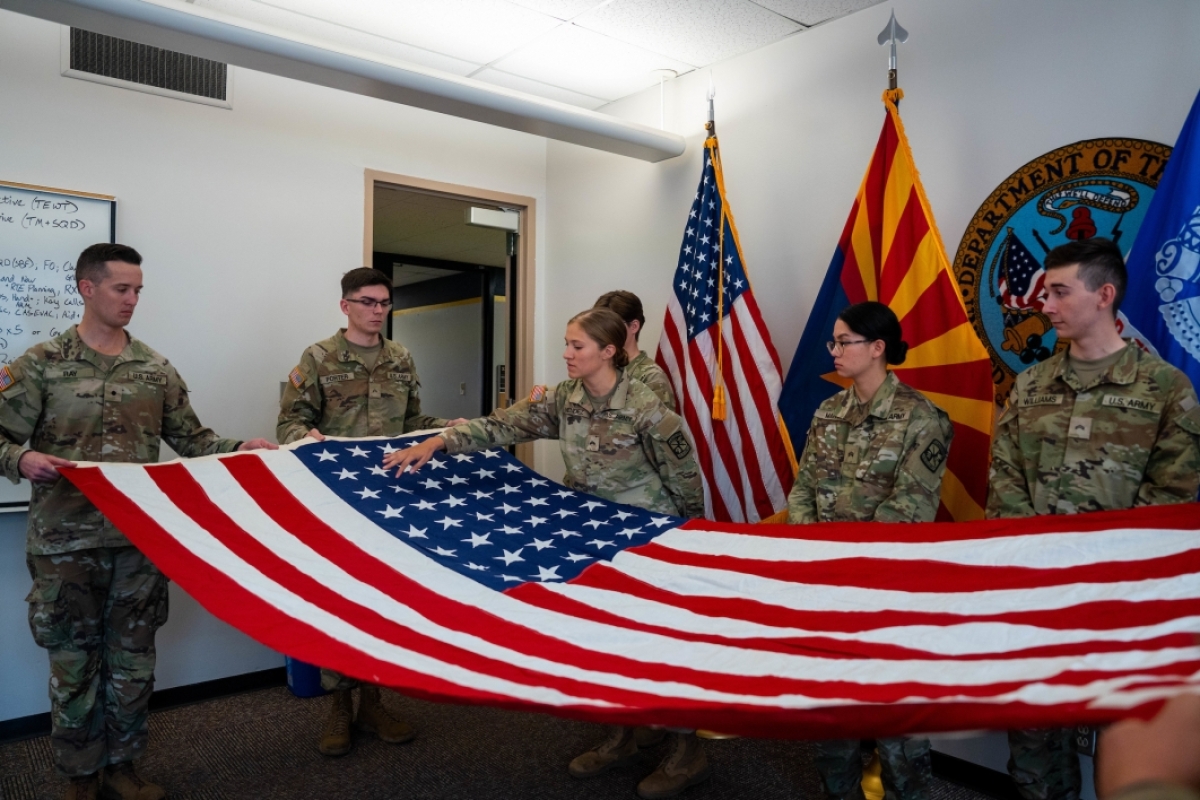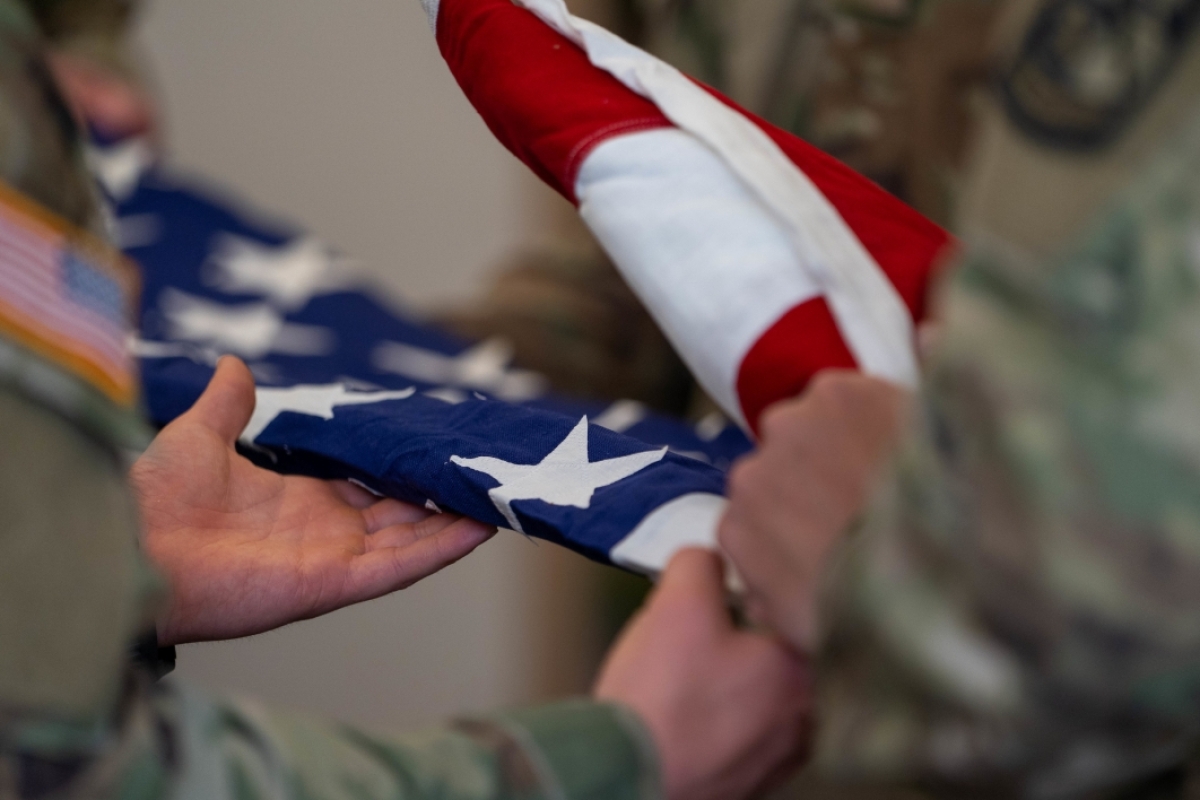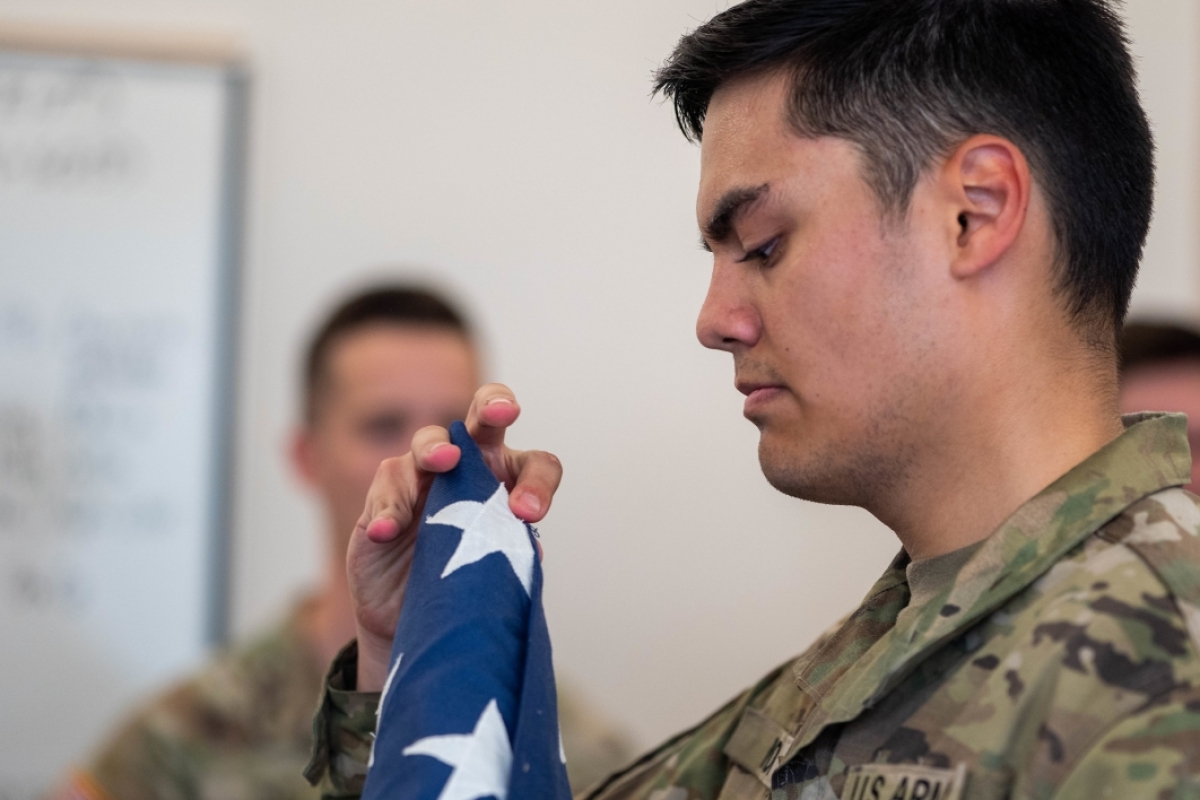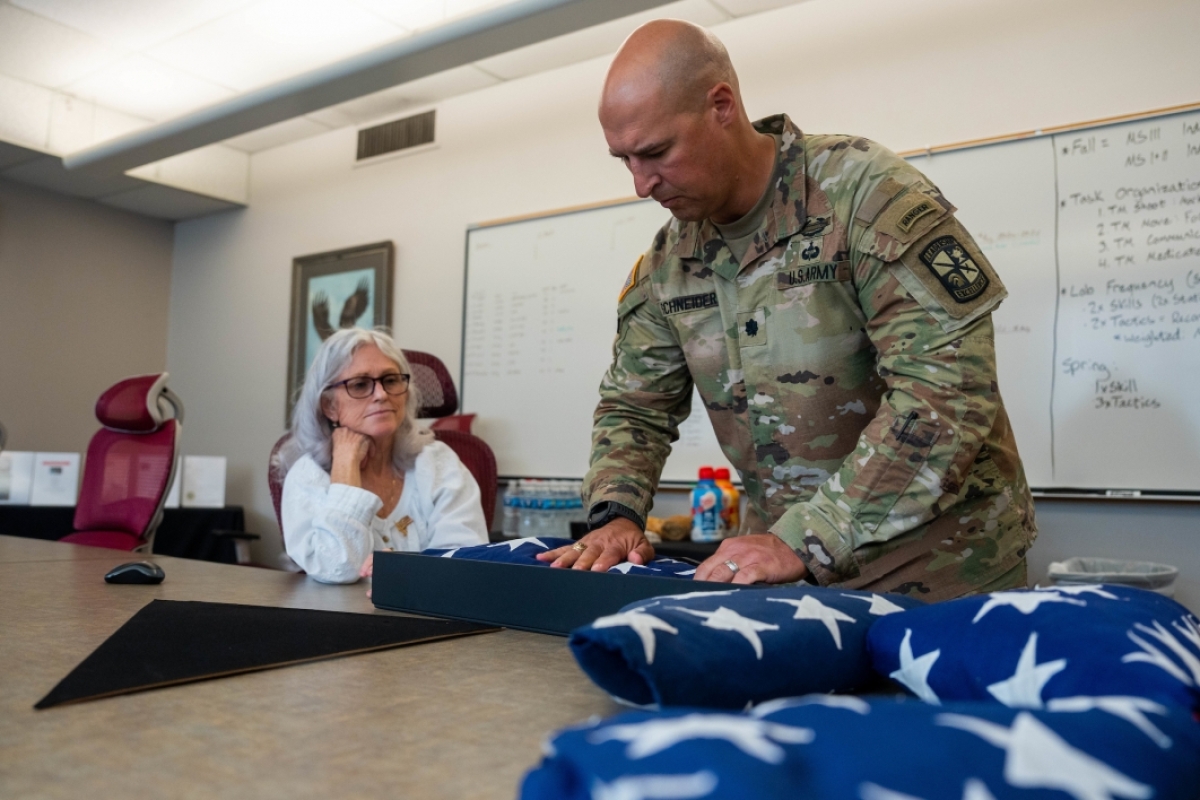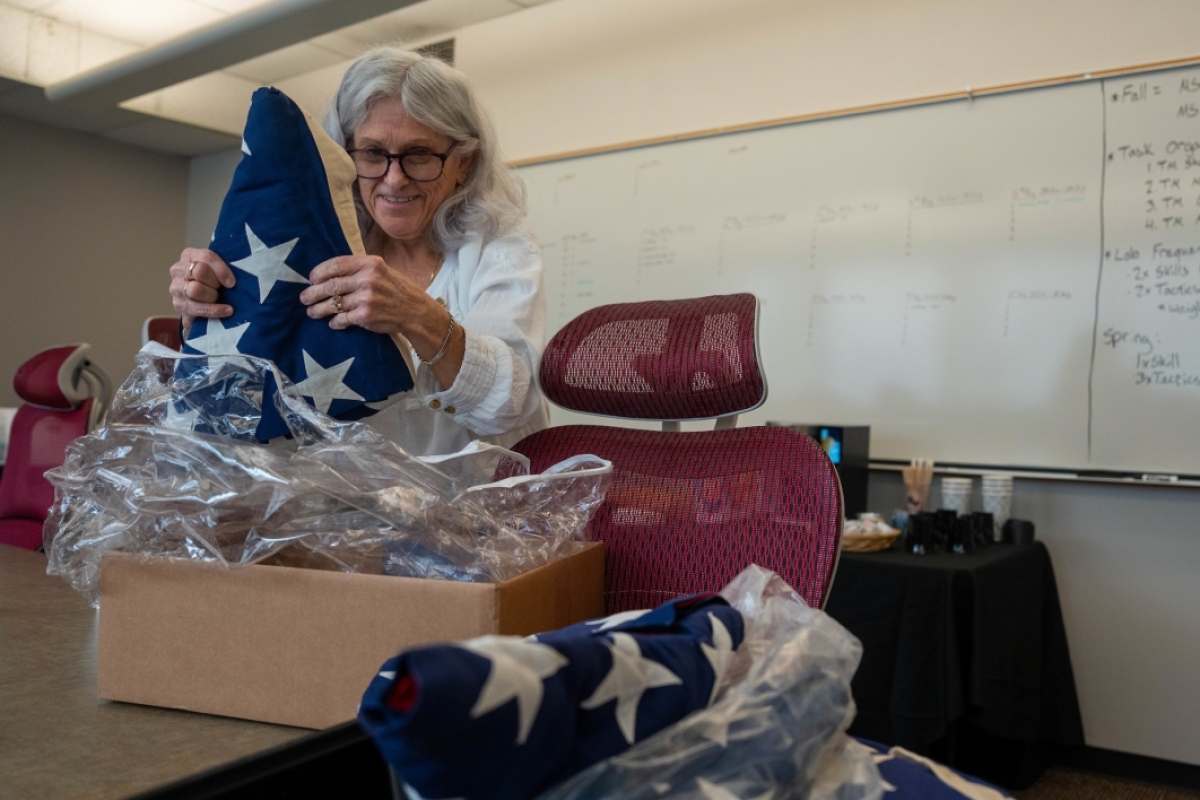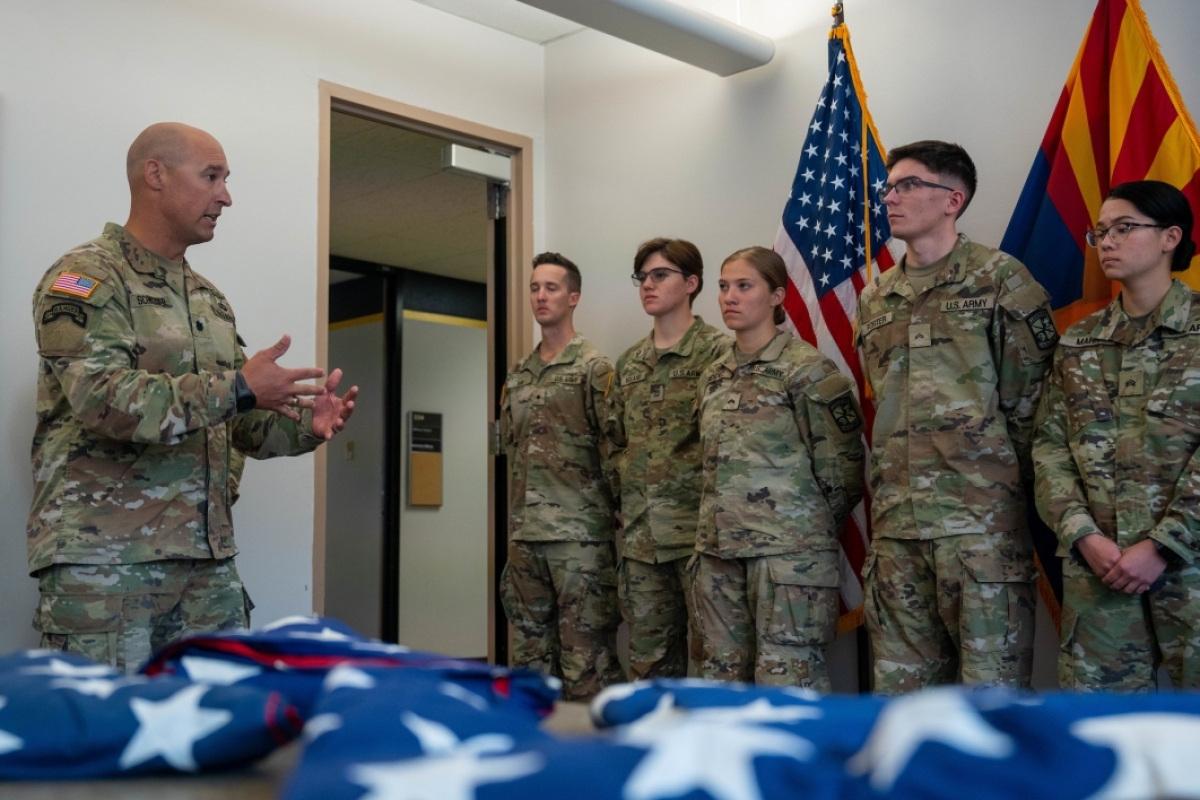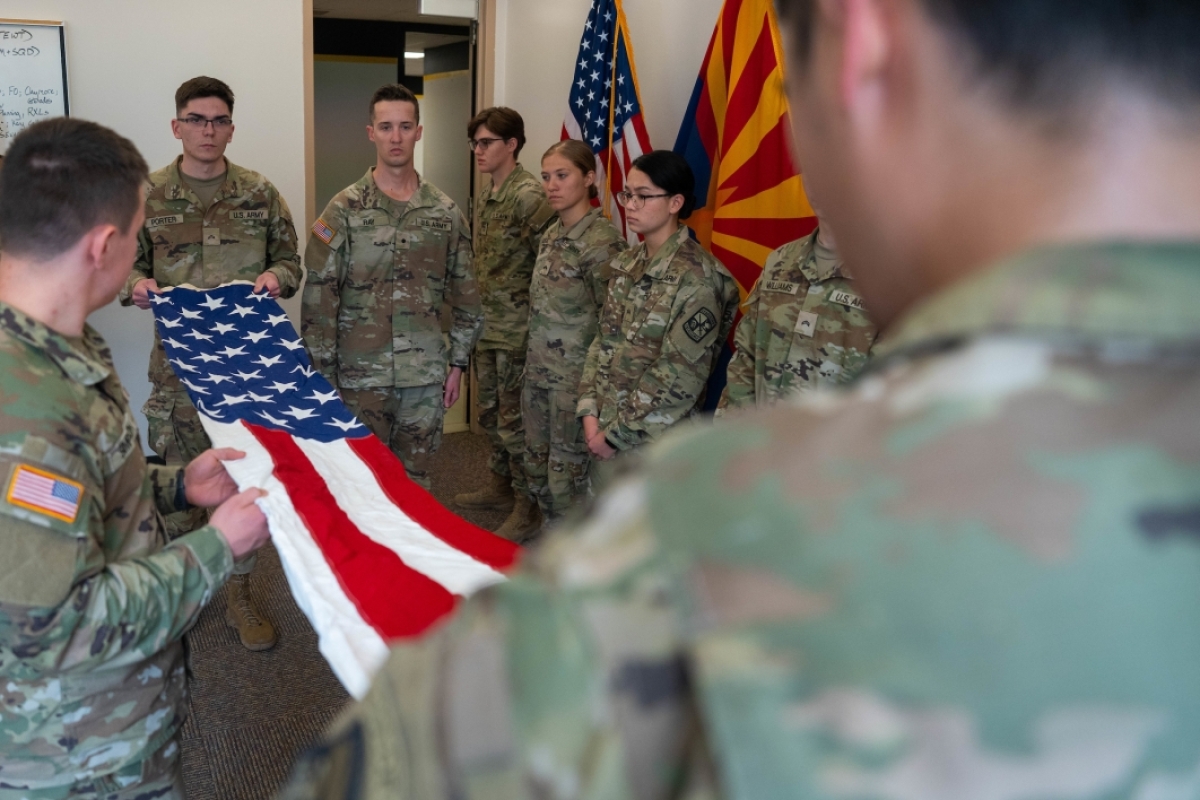Holding history
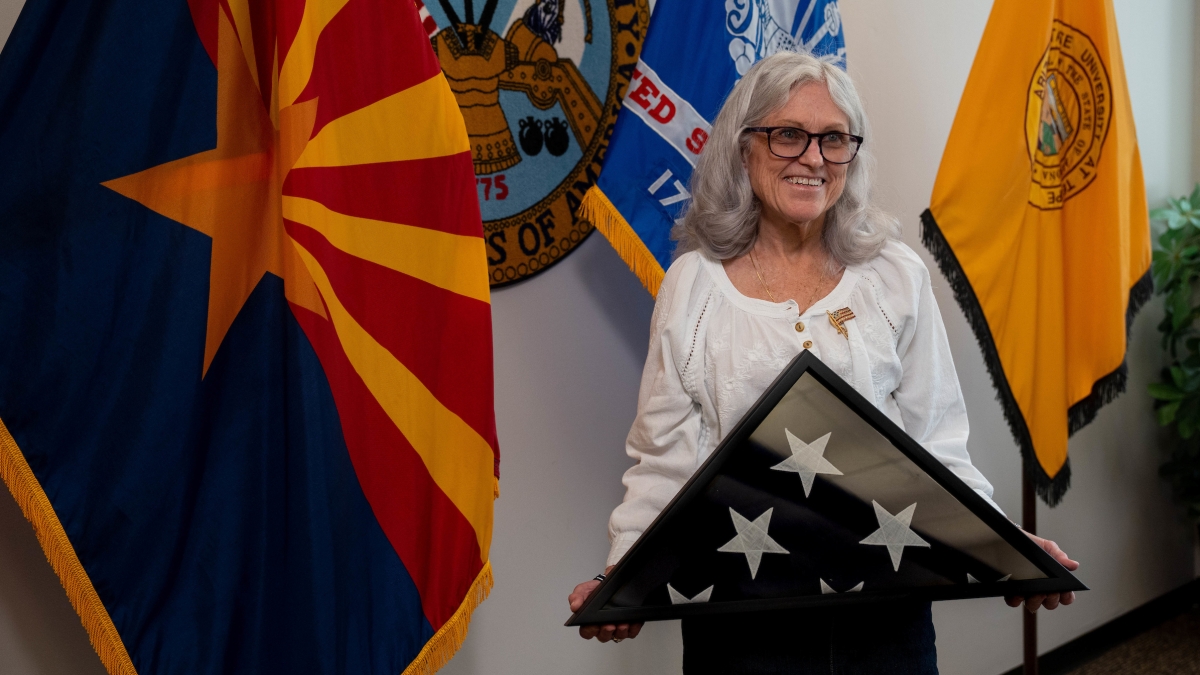
Denise Riggs poses for a photo with her uncle's U.S. casket flag at the Social Sciences Building on the Tempe campus on March 24. The ASU ROTC helped her identify the flag, which was from the Korean War, and properly fold the flag for storage. Photo by Samantha Chow/ASU
Editor’s note: This story is featured in the 2023 year in review.
Denise Riggs never met her late uncle, Carl Lay. But she feels closer to him than a lot of her other relatives.
For more than six decades, she has been piecing together his life and mysterious death. And thanks to Arizona State University's Army ROTC, she’s finally getting some closure.
“As I little girl, I never knew much about my Uncle Carl,” said Riggs, a retired clerk from Chandler, Arizona. “It wasn’t talked about much, but I could hear people saying small things here and there.”
Pfc. Carl Shelby Lay was 17 years old when he was killed in action during the Korean War. The news of his death, coupled with how his family was told, compounded their grief.
A confusing series of Defense Department telegrams starting on July 25, 1953, informed Lay’s parents, Earl and Mildred, that their son was wounded in combat on July 16. A second telegram on July 28 stated that Carl “was in a hospital and would soon be on his way home.” The third telegram, which arrived on July 31, informed them their son had died of wounds in Korea on July 16. Then they heard nothing for a few weeks and were left in the lurch.
Frustrated, Mildred had cabled her son’s hospital and his commanding officer. She also queried the American Red Cross. She received no answers. It was only after Arizona Republic reporter Virgil Meibert intervened on their behalf that the Lays finally heard from the Defense Department on Aug. 17, 1953. The Army later explained that their confusion arose because “all three messages were started on their way by different events, which all happened on the same day.”
However, it was Meibert, not the Army or Washington officials, who confirmed the grim news to Earl Lay that his son was dead. Carl’s remains were returned to Arizona in late October.
Graveside services were conducted by the American Legion a few days after the return of Carl’s body. Lay also received seven service medals, including a Purple HeartThe Lay family refused all of Carl Lay's service medals because of their grief and the way the Army handled the news of his death. . A flag with 48 starsCarl Lay’s U.S. flag represented the 48 states at the time — Alaska and Hawaii did not enter statehood until 1959. was presented to his parents at the end of the service. It was fitting for a soldier’s funeral, but Lay’s final resting place at Phoenix’s Greenwood Memorial Lawn Cemetery had no headstone or marker.
“I don’t know if that’s because the military would not pay for one or if my grandparents refused,” Riggs said. “They were angry and crushed. They were from a generation that didn’t talk about sad subjects.”
The Lays silently suffered for decades and rarely spoke of their son’s passing. They did keep a framed 8x10 high school photo of Carl on the side of their furnace. Riggs, who was born three years after Carl’s death, kept asking about the young man in the photo when she was a child. She only received cryptic or clipped answers. Sometimes her questions elicited tears, so she stopped asking.
If Riggs wanted answers, then she’d have to find them on her own.
The 'Forgotten War'
The Korean War, which was depicted in the popular TV show “M*A*S*H,” was called “the Forgotten War” by the New York Times. Its coverage was censored, and the conflict was bookended and overshadowed by World War II and the Vietnam War. But ask any military historian and they'll tell you that all wars are bloody; the Korean War was no exception.
It was a series of battles over a series of hills in horrible fighting situations. Summers were hot and humid while the winters were bitter cold. Seoul changed hands so many times between South and North Korea it became almost a deserted ruin. Soldiers were killed in ambushes with bayonets and knives, machine-gunned down, attacked by mortars and at times they resorted to hand-to-hand combat. There were approximately 33,700 battle deaths and more than 103,000 soldiers wounded in Korea, according to the U.S. Department of Veteran Affairs.
When Riggs turned 18, she grew more curious and bolder. She was pen pals with a great-uncle, Howard Lay, who lived in Russell, Kansas. After a few niceties, he finally revealed to her in a March 29, 1975, letter that his nephew had died in hand-to-hand combat.
“You are the first person to know that,” he wrote. “He (Carl) died a real soldier’s death.”
Through additional research, Riggs discovered her uncle was killed at the battle of Christmas Hill during the waning days of the Korean War. The armistice, which split North and South Korea at the 38th parallel, was signed July 27, 1953 — 11 days after Carl’s death.
Through Howard Lay's letter, Riggs finally received an answer regarding her uncle’s death. But she never got closure. Too many details were still missing, and many blanks needed to be filled in. She wanted to not only know how he died, but how he lived. She pried some information out of her mother, Vina, Carl’s younger sister.
Carl Lay was born on Sept. 19, 1935, in Phoenix. As a young boy and teen, he was described as rambunctious, inquisitive and exceptionally bright. He was in high school and driving a truck for Arizona Fence Builders when he enlisted with the Army’s 45th infantry division in September 1952. Carl was barely 17, an act that required his parents’ approval. They gave it to him but were reluctant. They later regretted the decision.
When Carl’s 76-year-old mother Mildred passed away in 1993, Riggs inherited a few items: a military photo of Carl plus four U.S. flags, one of which was stored in plastic. The one in plastic was thought to be Carl’s; the others belonged to various family members who served in the military and died of natural causes. Riggs asked her mother if she wanted the items. Riggs was told no and kept them.
For three decades, Riggs tried to identify which flag was her uncle’s because she wanted it stored in a case. She did not touch them out of respect to her uncle, his service and her family. She also knew there were protocols in place on how to handle and fold a U.S. flag. Riggs contacted various organizations she thought could help. Phone calls were either not returned or she was referred to another organization. A few months ago, Riggs vented her frustration to her friend, Chris Costa, while out on a walk.
Costa, a former health care manager and textbook contributor, had been a friend since 1987. She had even taken care of Carl's father after he fell and broke his hip. Costa took in the information and at the end of their walk said, “Give me a week.”
A teaching moment
It didn’t take long for inspiration to strike. Costa’s nephew, Steven, was a member of the ASU Army ROTC and the Army's Officer Candidate School. He often recounted for her how his ROTC and OCS experiences enhanced and later shaped his military performance. She picked up the phone and dialed ASU.
Costa spoke to Liza Steele, a military science coordinator at ASU, during the winter break.
“We’ve received a lot of calls for a color guard, but not to unfold and fold a flag for a Korean War veteran,” Steele said. “So, this was definitely the first one.”
Steele relayed the information to Army Lt. Col. Erich Schneider, who thought it could be a teaching moment for his cadets.
“We really do want to give back to the community because we’re a service-based organization,” said Schneider, who is a professor of military science. “Volunteerism is important to us. When we first heard about this story, we saw it as a great opportunity to give back to and offer some closure to a lady who had been wanting it for decades.”
The flag, Schneider says, is not only a symbol of freedom, but a symbol of service. In Carl Lay’s case, Schneider says his service represents the ultimate sacrifice made to our country.
“It’s very important that our family, friends and country recognize people like Carl Lay,” Schneider said. “The ultimate sacrifice is not gone or forgotten … it’s always remembered.”
The ceremony
On March 24, Carl Lay’s sacrifice was properly remembered in a conference room on the third floor of the Social Sciences Building where the Department of Military Science is housed on the Tempe campus. Seven Army ROTC cadets performed a flag-folding ceremony for the four banners in Riggs’ possession.
At 11:42 a.m., Army ROTC cadet Austin Nixon coordinated and led the ceremony. Nixon, a business major in the W. P. Carey School of Business, said his team spent four weeks studying and researching the history of flag folding in preparation for the big day.
“It was a lot of pressure to bring closure to a family of a fallen comrade of ours,” said Nixon, whose great grandfather, grandfather and father all served in the military. “This is a great honor for us.”
That’s why Army ROTC Cadet Zachary Ray wanted to participate. Ray's grandfather was a Korean War veteran.
“Most of us here don’t have military experience, so it helps us to understand the gravity of the decisions we make and how important this training is for us,” said Ray, who is a civil engineering major in the Ira A. Fulton Schools of Engineering. “We take this seriously and understand it. This was a super neat experience.”
The simple ceremony turned out to be suspenseful. Nixon’s team counted the stars one by one on the first three flags — each had 50. The dozen bystanders in the room wondered if the next flag was going to be Carl Lay’s — or if the ceremony was going to be a bust.
When the fourth and final flag was unfurled, Nixon was certain they were holding a piece of history.
“As soon as I opened that fourth flag, it dawned on me the stitching was different, the star alignment was different,” he said. “We got it in the end.”
Moments later the item was placed in a personalized display case Costa bought for Riggs.
Riggs also received something in the end as well — closure.
“It’s final now,” she said a few days after the ceremony. “I wake up in the morning, walk into the living room and see Carl’s folded flag and smile.
“'There you are!' I say to him. 'We’ve found you!'"
More Arts, humanities and education

Professor's acoustic research repurposed into relaxing listening sessions for all
Garth Paine, an expert in acoustic ecology, has spent years traveling the world to collect specialized audio recordings.He’s been to Costa Rica and to Ecuador as part of his research into innovative…

Filmmaker Spike Lee’s storytelling skills captivate audience at ASU event
Legendary filmmaker Spike Lee was this year’s distinguished speaker for the Delivering Democracy 2025 dialogue — a free event organized by Arizona State University’s Center for the Study of…

Grammy-winning producer Timbaland to headline ASU music industry conference
The Arizona State University Popular Music program’s Music Industry Career Conference is set to provide students with exposure to exciting career opportunities, music professionals and industry…


